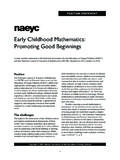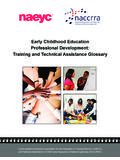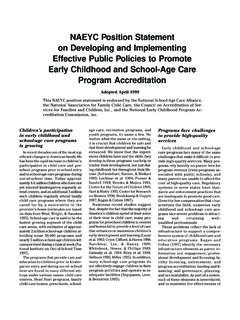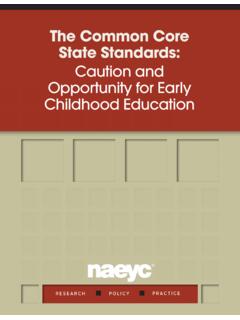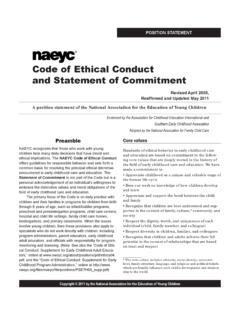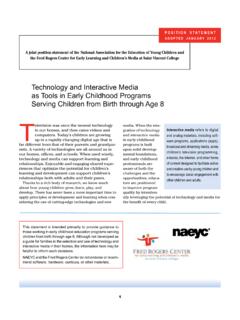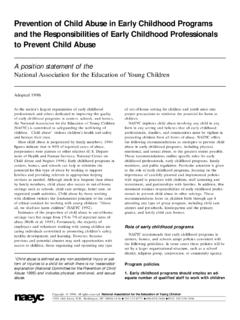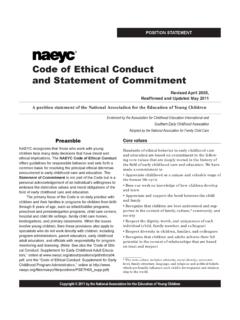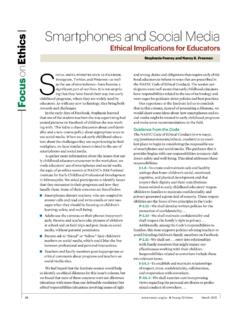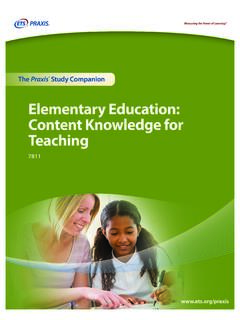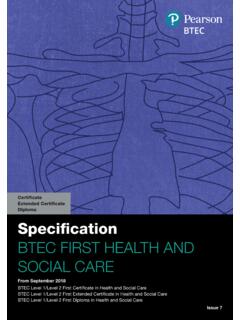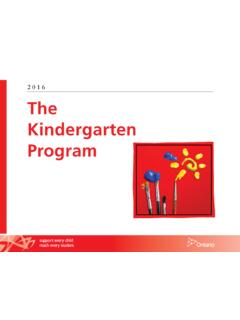Transcription of Developmentally Appropriate Practice in Early Childhood ...
1 Position Statement Developmentally Appropriate Practice in Early Childhood Programs Serving Children from Birth through Age 8. Adopted 2009. A position statement of the National Association for the Education of Young Children The purpose of this position statement is to pro- a late 2006 convening of respected leaders in the mote excellence in Early Childhood education by field. The result of this broad gathering of views is providing a framework for best Practice . Grounded this updated position statement, which addresses both in the research on child development and the current context and the relevant knowledge learning and in the knowledge base regarding base for Developmentally Appropriate Practice and educational effectiveness, the framework outlines seeks to convey the nature of such Practice clearly Practice that promotes young children's optimal and usefully.
2 Learning and development. Since its first adoption This statement is intended to complement in 1986, this framework has been known as devel- NAEYC's other position statements on Practice , opmentally Appropriate which include Early Learning Standards and Early The profession's responsibility to promote Childhood Curriculum, Assessment, and Program quality in the care and education of young children Evaluation, as well as the Code of Ethical Conduct compels us to revisit regularly the validity and cur- and NAEYC Early Childhood Program Standards and rency of our core knowledge and positions, such Accreditation as this one on issues of Practice . Does the position need modification in light of a changed context?
3 Is there new knowledge to inform the statement? Are Note : Throughout this statement, the terms teacher, practitioner, there aspects of the existing statement that have and educator are variously used to refer to those working in the Early Childhood field. The word teacher is always intended to given rise to misunderstandings and misconcep- refer to any adult responsible for the direct care and education tions that need correcting? of a group of children in any Early Childhood setting. Included are Over the several years spent in developing not only classroom teachers but also infant/toddler caregivers, family child care providers, and specialists in other disciplines this revision, NAEYC invited the comment of Early who fulfill the role of teacher.
4 In more instances, the term prac- Childhood educators with experience and exper- titioners is intended to also include a program's administrators. Educators is intended to also include college and university tise from infancy to the primary grades, including faculty and other teacher trainers. Copyright 2009 by the National Association for the Education of Young Children 2. Critical issues in the current context Since the 1996 version of this position statement, that optimistic future is not equally likely for all of the landscape of Early Childhood education in the the nation's schoolchildren. Most disturbing, low- United States has changed significantly and a num- income and African American and Hispanic stu- ber of issues have grown in importance.
5 Shortage dents lag significantly behind their peers on stan- of good care for children in the highly vulnerable dardized comparisons of academic achievement infant and toddler years has become Issues throughout the school years, and they experience of home language and culture, second language more difficulties while in the school learning, and school culture have increased with Behind these disparities in school-related the steady growth in the number of immigrant fami- performance lie dramatic differences in children's lies and children in our In addition, far Early experiences and access to good programs more children with special needs (including those and schools. Often there is also a mismatch with disabilities, those at risk for disabilities, and between the school culture and children's cul- those with challenging behaviors) participate in typ- tural A prime difference in chil- ical Early Childhood settings today than in the dren's Early experience is in their exposure to As for teachers, the nation continues to struggle language, which is fundamental in literacy devel- to develop and maintain a qualified teaching opment and indeed in all areas of thinking and This difficulty is especially acute in the under- learning.
6 On average, children growing up in low- funded Early Childhood arena, especially the child income families have dramatically less rich experi- care sector, which is losing well prepared teaching ence with language in their homes than do middle- staff and administrators at an alarming class children:11 They hear far fewer words and are Looking forward, demographic trends predict engaged in fewer extended conversations. By 36. a modest growth in the number of young children months of age, substantial socioeconomic dispari- in the population, significant increases in the ties already exist in vocabulary knowledge,12 to demand for Early care and education, dramatic name one area. increases in children's cultural and linguistic diver- Children from families living in poverty or in sity, and unless conditions change, a greater share households in which parent education is low typi- of children living in poverty.
7 Among these, the cally enter school with lower levels of foundational biggest single child-specific demographic change skills, such as those in language, reading, and in the United States over the next 20 years is pre- On starting kindergarten, children dicted to be an increase in children whose home in the lowest socioeconomic group have average language is not cognitive scores that are 60 percent below those Also significant is that policy makers and the of the most affluent group. Explained largely by public are far more aware of the importance of socioeconomic differences among ethnic groups, the Early Childhood years in shaping children's average math achievement is 21 percent lower for futures.
8 Based on this widespread recognition and African American children than for white children the context of Early Childhood education today, it and 19 percent lower for Hispanic children than was decided this statement would highlight three for non-Hispanic white Moreover, due to challenges: reducing learning gaps and increasing deep-seated equity issues present in communities the achievement of all children; creating improved, and schools, such Early achievement gaps tend to better connected education for preschool and increase rather than diminish over elementary children; and recognizing teacher Concerns over the persistence of achieve- knowledge and decision making as vital to educa- ment gaps between subgroups are part of a larger tional effectiveness.
9 Concern about lagging student achievement in the United States and its impact on American eco- Reducing learning gaps and increasing nomic competitiveness in an increasingly global economy. In comparisons with students of other the achievement of all children industrialized countries, for example, America's All families, educators, and the larger society students have not consistently fared well on tests hope that children will achieve in school and go of educational on to lead satisfying and productive lives. But Copyright 2009 by the National Association for the Education of Young Children 3. It is these worries that drive the powerful So we must close existing learning gaps and standards/accountability movement.
10 Among the enable all children to succeed at higher levels but movement's most far-reaching actions has been how? While this question is not a new one, in the the 2001 passing of No Child Left Behind (NCLB), current context it is the focus of increased atten- which made it national policy to hold schools tion. As later outlined in Applying New Knowledge accountable for eliminating the persistent gaps in to Critical Issues, accumulating evidence and achievement between different groups of children. innovations in Practice now provide guidance as With the aim of ensuring educational equity, the to the knowledge and abilities that teachers must law requires the reporting of scores disaggregated work especially hard to foster in young children, as by student group; that is, reported separately for well as information on how teachers can do so.
